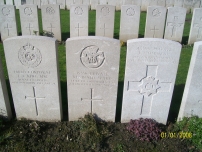| First Name: | Reginald | Last Name: | WARD | |
|---|---|---|---|---|
| Date of Death: | 07/11/1917 | Lived/Born In: | Penge | |
| Rank: | Private | Unit: | Cornwall Light Infantry1 | |
| Memorial Site: | Penge Memorial | |||
Current Information:Age-20 28, Crampton Road, Penge Born-Peckham Lijssenthoek Military Cemetery, Belgium
Third Battle of Ypres This was a campaign fought between July and November 1917 and is often referred to as the Battle of Passchendaele, a village to the north-east of Ypres which was finally captured in November. It was an attempt by the British to break out of the Ypres salient and capture the higher ground to the south and the east from which the enemy had been able to dominate the salient. It began well but two important factors weighed against them. First was the weather. The summer of 1917 turned out to be one of the the wettest on record and soon the battlefield was reduced to a morass of mud which made progress very difficult, if not impossible in places. The second was the defensive arrangements of concrete blockhouses and machine gun posts providing inter-locking fire that the Germans had constructed and which were extremely difficult and costly to counter. For 4 months this epic struggle continued by the end of which the salient had been greatly expanded in size but the vital break out had not been achieved. The Second Battle of Passchendaele. 26 October, 1917–10th November, 1917 Although all the fighting during Third Ypres is often referred to as the Battle of Passchendaele, that name officially belongs to two battles fought late in the campaign. The second of these, the final battle of the campaign, was fought between 26th October and 10th November, 1917, when Canadian and British troops of Second Army attacked the Passchendaele ridge, capture of which would have given them sight of the important railway junction at Roulers, a vital part of the German supply network. At the same time, units from Fifth Army attacked further north. The battle was a success inasmuch as the high ground along the Passchendaele-Westrozebeke ridge ended up in British hands but once again the casualty rate was very high. At this stage and much to Field Marshall Haig’s chagrin, some British divisions were withdrawn from Flanders and sent to Italy to assist the Italian Army after their defeat at the Battle of Caporetto, while others were removed to take part in the forthcoming offensive at Cambrai. As a result of this the whole campaign of 3rd Ypres was terminated. On 6th November, in conjunction with the Canadians, 95 Brigade of 5th Division attacked north of the Menin road. 1st Cornwall Light Infantry led the way with 1st Devonshire in close support and they immediately came under machine-gun fire from Polderhoek chateau. Both battalions reached some shell holes to the north-west of the chateau where they captured a German pillbox and established a makeshift line, but the attack was unable to continue and broke down into small parties involved in scattered bombing (grenade) fights. To add to their woes the enemy then opened up a heavy artillery bombardment which lasted two hours. By mid afternoon the left of the attack had been pulled back to their original positions but contact was maintained with those of 1st Devonshire in the captured pillbox. Reginald Ward of 1st Cornwall died from wounds the following day, 7th November.
|
||||
| « Back to Search Results | ||||
| If you think any of the information shown here is incorrect, Click Here to submit your amends and comments | ||||




